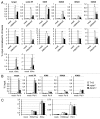MORC proteins and epigenetic regulation
- PMID: 23072987
- PMCID: PMC3578893
- DOI: 10.4161/psb.22460
MORC proteins and epigenetic regulation
Abstract
Two recent studies in Arabidopsis implicated MORC proteins, which contain a GHKL ATPase domain, in transcriptional gene silencing. Here, these studies are compared and contrasted to discuss the roles of MORC proteins in epigenetic regulation. Although MORC proteins are likely to catalyze changes in chromatin structure in response to epigenetic signals, their precise mode of action and target site-specificity still remain unclear.
Keywords: Arabidopsis; DNA methylation; GHKL ATPase; H3K27 monomethylation (H3K27me); MORC; RNA directed DNA methylation; histone modification.
Figures



References
Publication types
MeSH terms
Substances
LinkOut - more resources
Full Text Sources
